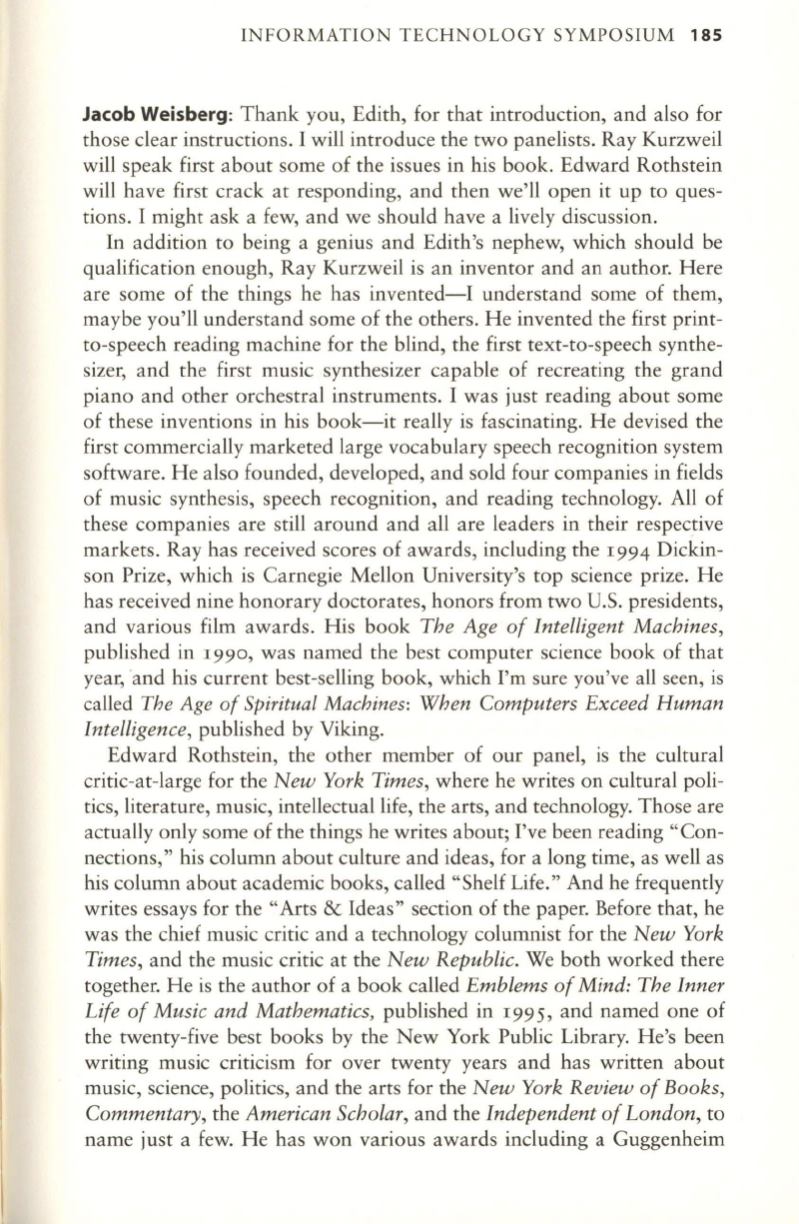
INFORMATION TECHNOLOGY SYMPOSIUM
185
Jacob Weisberg:
Thank you, Edith, for that introduction, and also for
those clear instructions. I will introduce the two panelists. Ray Kurzweil
will speak first about some of the issues in his book. Edward Rothstein
will have first crack at responding, and then we'll open it up to ques–
tions. I might ask a few, and we should have a lively discussion.
In addition to being a genius and Edith's nephew, which should be
qualification enough, Ray Kurzweil is an inventor and an author. Here
are some of the things he has invented-I understand some of them,
maybe you'll understand some of the others. He invented the first print–
to-speech reading machine for the blind, the first text-to-speech synthe–
sizer, and the first music synthesizer capable of recreating the grand
piano and other orchestral instruments. I was just reading about some
of these inventions in his book-it really is fascinating. He devised the
first commercially marketed large vocabulary speech recognition system
software. He also founded, developed, and sold four companies in fields
of music synthesis, speech recognition, and reading technology. All of
these companies are still around and all are leaders in their respective
markets. Ray has received scores of awards, including the
1994
Dickin–
son Prize, which is Carnegie Mellon University's top science prize. He
has received nine honorary doctorates, honors from two U.S. presidents,
and various film awards. His book
The Age of Intelligent Machines,
published in
1990,
was named the best computer science book of that
year, ·and his current best-selling book, which I'm sure you've all seen, is
called
The Age of Spiritual Machines: When Computers Exceed Human
Intelligence,
published by Viking.
Edward Rothstein, the other member of our panel, is the cultural
critic-at-Iarge for the
New York Times,
where he writes on cultural poli–
tics, literature, music, intellectual life, the arts, and technology. Those are
actually only some of the things he writes about; I've been reading "Con–
nections," his column about culture and ideas, for a long time, as well as
his column about academic books, called "Shelf Life." And he frequently
writes essays for the "Arts
&
Ideas" section of the paper. Before that, he
was the chief music critic and a technology columnist for the
New York
Times,
and the music critic at the
New Republic.
We both worked there
together. He is the author of a book called
Emblems of Mind: The Inner
Life of Music and Mathematics,
published in
1995,
and named one of
the twenty-five best books by the New York Public Library. He's been
writing music criticism for over twenty years and has written about
music, science, politics, and the arts for the
New York Review of Books,
Commentary,
the
American Scholar,
and the
Independent of London,
to
name just a few. He has won various awards including a Guggenheim


